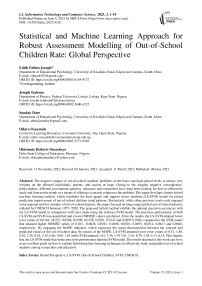Statistical and Machine Learning Approach for Robust Assessment Modelling of Out-of-School Children Rate: Global Perspective
Автор: Edith Edimo Joseph, Joseph Isabona, Sunday Dare, Odaro Osayande, Okiemute Roberts Omasheye
Журнал: International Journal of Information Technology and Computer Science @ijitcs
Статья в выпуске: 3 Vol. 15, 2023 года.
Бесплатный доступ
The negative impact of out-of-school students' problems at the basic and high-school levels is always very weighty on the affected individuals, parents, and society at large. Owing to the weighty negative consequences, policymakers, different government agencies, educators and researchers have long been looking for how to effectively study and forecast the trends as a means of offering a concrete solution to the problem. This paper develops a better hybrid machine learning method, which combines the least square and support vector machine (LS-SVM) model for robust prediction improvement of out-of-school children trend patterns. Particularly, while other previous works only engaged some regional and few samples of out-of-school datasets, this paper focused on long-ranged global out-of-school datasets, collated by UNESCO between 1975- 2020. The proposed hybrid method exhibits the optimal precision accuracies with the LS-SVM model in comparison with ones made using the ordinary SVM model. The precision performance of both LS-SVM and SVM was quantified and a lower NRMSE value is preferred. From the results, the LS-SVM attained lower error values of 0.0164, 0.0221, 0.0268, 0.0209, 0.0158, 0.0201, 0.0147 and 0.0095 0.0188, compared to the SVM model that attained higher NRMSE values of 0.041, ,0.0628, 0.0381, 0.0490, 0.0501, 0.0493, 0.0514, 0.0617 and 0.0646, respectively. By engaging the MAPE indicator, which expresses the mean disconnection between the sourced and predicted values of the out-of-school data. By means of the MAPE, LS-SVM attained lower error values of 0.51, 1.88, 0.82, 2.38, 0.62, 2.55, 0.60, 0.60, 1.63 while SVM attained 1.83, 7.39, 1.79 7.01, 2.43, 8.79, 2.58, 4.13, 6.18. This implies that the LS-SVM model has better precision performance than the SVM model. The results attained in this work can serve as an excellent guide on how to explore hybrid machine-learning techniques to effectively study and predict out-of-school students among researchers and educators.
Global Perspective, LS-SVM, Out-of-School Children, SVM, UNESCO
Короткий адрес: https://sciup.org/15018932
IDR: 15018932 | DOI: 10.5815/ijitcs.2023.03.01
Текст научной статьи Statistical and Machine Learning Approach for Robust Assessment Modelling of Out-of-School Children Rate: Global Perspective
Proper education remained a better means of boosting individual well-being, fighting poverty, combating crime, reducing social vices, fostering peace, strengthening egalitarianism, sustaining the environment, and ensuring gender parity in society. Proper, education can also prepare and enhance learners' ability to obtain the right attitude and acquire the skills they need, including sense of purpose in order to improve their individual lives.
Generally, children who had non-formal education or fall within the pre-primary or primary education that are not in school, are regarded as out-of-school, the most susceptible and sidelined children in society today are out-of-school children (OOSC) [1]. This is because they are cut off from the well-being and security net that the school offers, which in turn places them at a greater menace of abuse, exploitation, denial, and a lifetime of poverty (UNICEF, 2022) [2].
Though a substantial quantum leap toward attaining universal primary education has been realized over the years in many countries, however, the OOSC number in terms of global statistics still remains unacceptably high. For example, a published report by UNESCO [1], in September 2021 but which was updated in 2022, indicates that 244 million children within the 6-18 age range were still not in school worldwide. In the same vein, Sub-Saharan Africa alone owns about 40.16% of the 244 million children number that were not formally registered in school. According to UNICEF, (2022) [2], Central and West Africa alone houses almost one-fourth of out-of-school children number in the world.
In Eastern and Southern Africa, it is reported that one in nine children is not registered in school. In Latin America and the Caribbean region, three million, eight hundred thousand number of primary school-age children are not in school. In Central and Eastern Europe, about 1.0 million children-age and 1.2 adolescents teenage are not in school in that region. Similar reports on high out-of-school children's numbers, particularly at the primary and teenage levels are also recorded for West and Central Africa, South Asia, North Africa, Middle Each, and others.
The negative impact of aforementioned out-of-school students' problems at the basic and high-school levels is always very weighty on the affected individuals, parents, and society at large can large globally, if not properly and timely handled. Our main objective in this paper is to come up with a better hybrid machine learning method, which combines the least square and support vector machine (LS-SVM) model for robust prediction improvement of out-of-school children trend patterns.
2. Literature Review
For the past decade, many strategies have been adopted by researchers to discuss and reliable predict as means of tackling the societal prevalence of out-of-school children problem. Though a lot of effort has been put forward, with substantial progress accomplished in this regard, however, many stones are still left unturned. Thus, this paper is designed to fill in the gap. However, a realistic approach to tackling the problem holistically from a global perspective is still missing.
In [3], a Decision Tree (DT) and Support Vector Machine (SVM) were both employed to predict learning disabilities among school-age kids, and from the results, the SVM delivered preferred accuracy compared to DT.
An automated machine learning (AuML) method was developed in [4], to Boost the predictive estimation of student dropout trends in post-primary schools. The AuML model achieves different accuracy values of 99.6, 97,99.8, and 99.6%, respectively.
The authors in [5], employed 5 different machine learning tools to conduct a prediction study on school Dropout trends among high-school students by engaging a series of parameters like education history, gender, absence, travel time, size of student class, school size, etc. From their research, Random Forest attained supreme performance over other machine learning methods such as Naïve Bayes, SVM, and CART. Said, (2020) [6] developed a predictive system for school dropout estimation by means of a robust classification algorithm and using a region Tabora as a clear-case study. After the analysis, Said realized that academic and social factors had the strongest effect on the prediction results. The authors in [7, 8] also utilized a classification algorithm-based prediction approach for student dropout analysis but used the Indian and South Korean as case studies. A review work that houses some methods adopted in different literature to conduct dropout and academic performance prediction is contained in [9-16].
The problem with the above explored and classical and machine learning methods is that they often achieved deficient prediction accuracies, particularly on high stochastic datasets [17-24].
This paper develops a better hybrid machine learning method, which combines the least square and support vector machine (LS-SVM) model for robust prediction improvement of out-of-school children. Particularly, while others only engaged some regional and few samples of out-of-school datasets, this paper focused on long-ranged global out-of-school datasets, collated between 1975- 2020, thus making our work to be more robust and all-inclusive. Thus, the following contributions are attained in this paper.
• Detailed Statistical Analysis of out-of-School children's data for Nine different regions of the World.
• Development of an improved hybrid machine learning method, using the least square and support vector machine (LS-SVM) model.
• Application of the improved hybrid machine learning prediction method for robust prediction improvement of out-of-school children.
3. Methodology3.1. Method of Data Collection
3.2. Least Square Support Vector Machine (LS-SVM)
This section presents the method of sourcing the out-of-school children's data, the considered machine learning model, which is LS-SVM in comparison with the classical SVM model, and the algorithm employed to perform the prediction process. Figure 1 display the step-by-step flowchart of the entire method implementation guide.
Databases that are specially designed always contain some important and hidden rich facts, which can be utilized further for specific data mining and robust intelligent decision-making. This has led to different interests in developing tools that can pave a way for automatic relevant data extraction and processing. According, the out-of-school data we explored in this paper is sourced from the official UNESCO site. The site houses numerous out-of-school datasets for different countries and regions of the world.
Specifically, we collected 45 years range of out-of-school children's data, starting from 1975-2020 and the datasets are for nine different regions, which include Sub-Sahara Africa (SSA), Middle and East Africa (MEA), Arab World (ARW), Europe and Centra Asia (ECA), Heavily Indebted Countries (HIC), Latin America and Caribbean (LAC), Least Developed Countries (LDC), Low and Middle-Income Countries (LMC), Southern Asia (SOA).
Here, we engaged the proposed LS-SVM model, which is an advanced form of the classical SVR model, to adaptively learn and predict the global out-of-school children’s data.
Now consider the out-of-school data in the form f(.) = [(x1,y1),..., (xk,yk) £ R1] , where xk £ R1 and yk £ R1 designate the input-out vectors such that, к = 1,... ,t and, with t and R1 indicating the specified observed data number and one dimensional vector space.
Intuitively, the input out vector can be mapped nonlinearly from the output vector in the form:
f(x) = (wтФ(x) + c (1)
where Ф(.) express the nonlinear mapping function and w £ R1 , with c and w designating the scaler threshold and the adjustable weight vector.
Specifically, with LS-SVM, the problem of optimization is defined by:
Min: 1 wTw + p1^ k = i e 2
Subject to:
f(x) = (wтФ(xk) + c+ ek , k=1, ..., t (2)
where p and ek express the regularization parameter and error variable.
By applying Langrangian multiplier method and after differentiation, we obtain where K (xk — xb) designates the kernel function.
y(x) = f(x) = 2k=i ^ k R(X k ,x) + c (3)
For A= (xk — xb) and considering the radial basis kennel function we have:
K(xk — xb) = K(A) = exp (— ^-)
where lw express the radial basis function width.
Figure 1 provides the implementation flowchart details of the various key steps adopted to meet our main objective in this paper, which is to come up with a better hybrid machine learning method, which combines the least square and support vector machine (LS-SVM) model for robust prediction improvement of out-of-school children trend patterns.
Input: Sourced out-of-school data
Output: Predicted out-of-school data
Step: (i) preprocess out-of-school data
Step: (ii) Load the out-of-school data
Step: (iii) Identify the LS-SVM key controlling parameters (hyperparameters)
Step: (iv) Code and the LS-SVM model in Matlab format
Step: (v) Apply the LS-SVM model
Step: (vi) Benchmark the LS-SVM model with the standard SVM model
Step: (vii) Display the LS-SVM and SVM model prediction performance
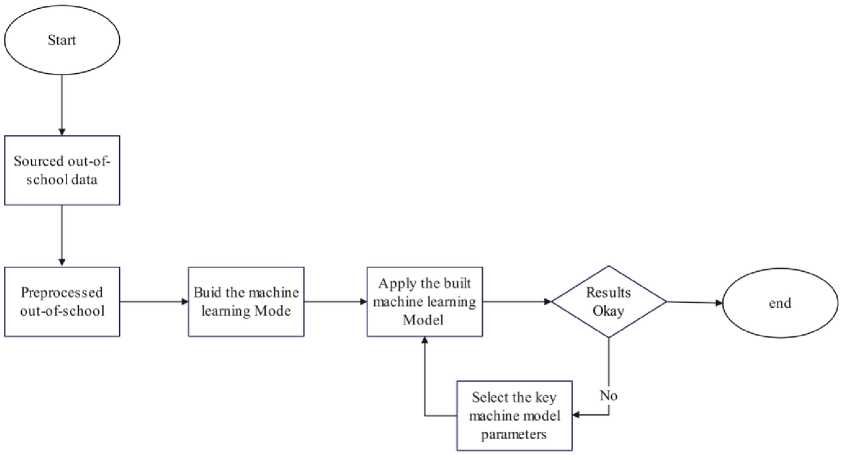
Fig.1. Proposed LS-SVM Model Implementation Flowchart
4. Results and Analysis
The results and analysis are presented in two parts. While the first concentrates on detailed statistical analysis of the acquired out-of-school data, the second parts the results with analysis of utilized LS-SVM model prediction performance on the school data over the standard SVM model.
-
4.1. Statistical Analysis of Out-of-School Children Data for Nine World Region
As mention earlier, we obtained 45 years range of out-of-school children’s data, starting from 1975-2020 and the datasets are for 9 different regions which include Sub-Sahara Africa (SSA), Middle and East Africa (MEA), Arab World (ARW), Europe and Centra Asia (ECA), Heavily Indebted Countries (HIC), Latin America and Caribbean (LAC), Least Developed Countries (LDC), Low and Middle-Income Countries (LMC), Southern Asia (SOA).
To present quantify and performance the statistical analysis, we explored for first order measures, which are sum, mean, maximum and minimum. The results in table 1 contains the quantified sum, mean, maximum and minimum values of out-of-school children’s statistical values.
Table 1. Quantified Statistical of Mean, Maximum, Minimum and Sum Values of Out-of-School Children Data for the Nine Different Nine regions
|
Mean |
Maximum |
Minimum |
Sum |
|
|
SSA |
3.59E+07 |
4.61E+07 |
2.87E+07 |
1.65E+09 |
|
MEA |
5.47E+06 |
7.86E+06 |
1.99E+06 |
2.52E+08 |
|
ARW |
8.65E+06 |
1.07E+07 |
6.39E+06 |
3.98E+08 |
|
ECA |
2.13E+06 |
3.69E+06 |
963149 |
9.78E+07 |
|
HIC |
2.75E+07 |
3.64E+07 |
2.20E+07 |
1.26E+09 |
|
LAC |
2.81E+06 |
5.50E+06 |
1.09E+06 |
1.29E+08 |
|
LDC |
3.14E+07 |
4.08E+07 |
2.36E+07 |
1.44E+09 |
|
LMC |
8.83E+07 |
1.18E+08 |
5.60E+07 |
4.06E+09 |
|
SOA |
3.06E+07 |
4.17E+07 |
1.36E+07 |
1.41E+09 |
The sum of out-of-school children number for SSA, MEA, ARW, ECA, HIC, LAC, LDC, LMC and SOA are 1.65263e+09, 2.51637e+08, 3.98093e+08, 9.77735e+07, 1.26404e+09, 1.29253e+08, 1.44231e+09, 4.06215e+09, 1.4057e+09, respectively.
The highest out-of-school children number attained by each of the groups stand at 4.60919e+07, 7.86439e+06, 1.07058e+07, 3.69399e+06, 3.63705e+07, 5.50487e+06, 4.07689e+07, 1.18148e+08, and 4.17e+07, respectively. Also, the lowest out-of-school children number attained by each of the groups stand at 2.87068e+07, 1.98647e+06, 6.38997e+06, 9.63149e+05, 2.20388e+07, 1.09029e+06, 2.35851e+07, 5.60109e+07, and 1.36e+07, respectively.
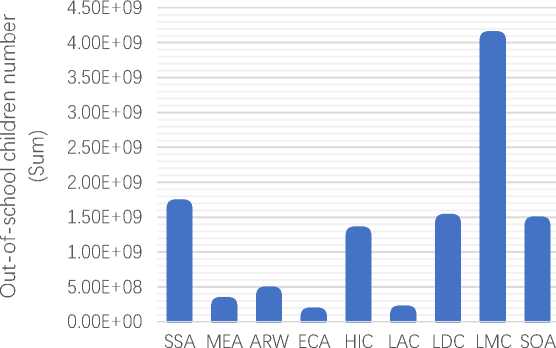
Studied Groups
Fig.2. Quantified Statistical of Sum Value Out-of-School Children Data for Nine Different Nine Regions
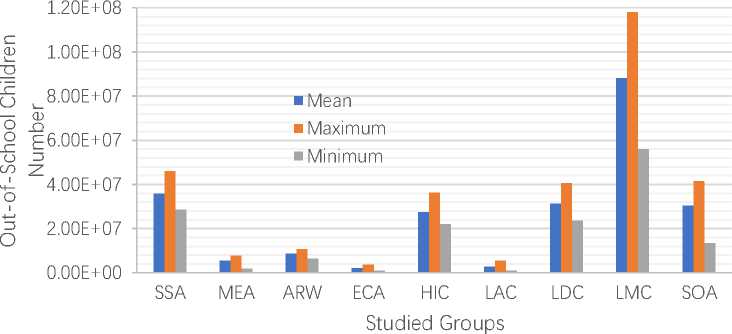
Fig.3. Quantified Statistical of Mean, Maximum and Minimum Values of Out-of-School Children Data for Nine Different Nine Regions
-
4.2. LS-SVM Model Prediction Performance Compared with the Standard SVM Model
This section provides the utilized LS-SVM model prediction performance on the school data over the standard SVM model. The key LS-SV M modelling control parameters such as the lw and p were obtained through exhaustive search process and its predictive learning performance were evaluated with Mean percentage error (MAPE), Correlation coefficient (R), and Normalized Root Mean Square Error (NRMSE):
The graphs in Figures 4-13 exhibit the optimal precision accuracies of the LS-SVM model in comparison with ones made using the ordinary SVM model. Precision performance of both LS-SVM and SVM quantified and displayed in each graph in term of NRMSE values.
With NRMSE, a lower value is preferred. From the graphs, the LS-SVM attained lower error values of 0.0164, 0.0221, 0.0268, 0.0209, 0.0158, 0.0201, 0.0147 and 0.0095 0.0188, compared to the SVM model that attained higher NRMSE values of 0.041, ,0.0628, 0.0381, 0.0490, 0.0501, 0.0493, 0.0514, 0.0617 and 0.0646, respectively.
By engaging the MAPE indicator, which expresses the mean disconnection between the sourced and predicted values of the out-of-school data. By means of the MAPE, LS-SVM attained lower error values of 0.51, 1.88, 0.82, 2.38, 0.62, 2.55, 0.60, 0.60, 1.63 while SVM attained 1.83, 7.39, 1.79 7.01, 2.43, 8.79, 2.58, 4.13, 6.18. This implies that LS-SVM model better precision performance over the SVM model. Moreover, by means of, R indicator, which quantifies the closeness or connection between predicted and sourced out-of-school children data values. In term of quantified correlation coefficient performance as reviewed in graphs of figures 14-21, it is also clearly unveiled that the LS-SVM outperform the ordinary SVM prediction model.
Fig.4. Predicted
Method for SSA
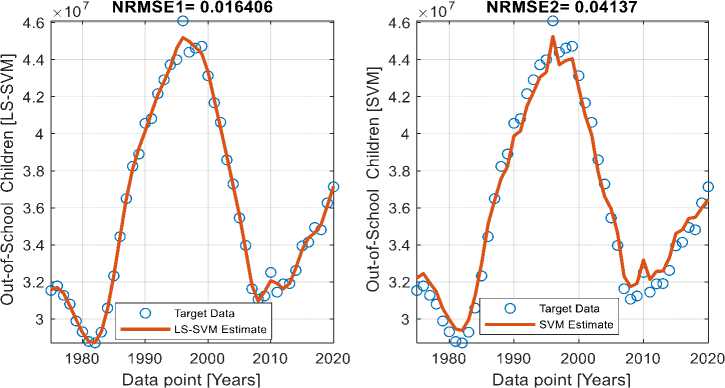
out-of-school Data Versus Data
Using the Proposed Hybrid LS-SVM Method and
Results of Sourced
the
Ordinary SVM
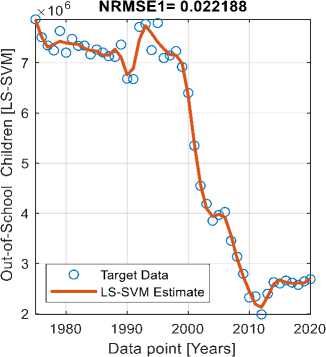
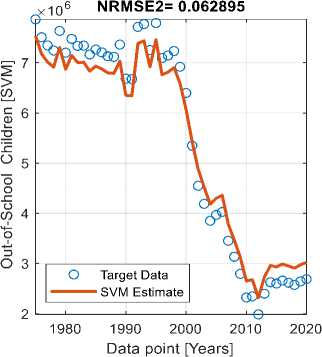
Fig.5. Predicted
Results of Sourced out-of-school Data Versus Data Using
Method for MEA
the Proposed Hybrid LS-SVM Method and the Ordinary SVM
Method for ARW
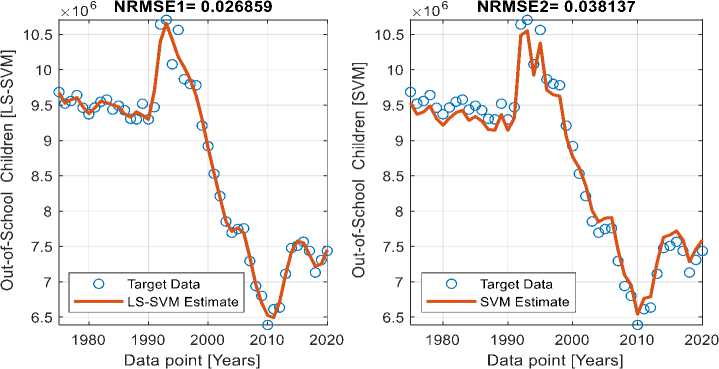
Fig.6. Predicted Results of Sourced out-of-school Data Versus Data Using the Proposed Hybrid LS-SVM Method and the
Ordinary SVM
Fig.8. Predicted
Method for HIC
Method for LMA
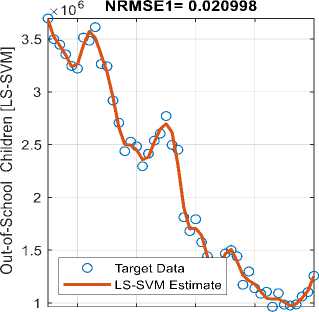
Fig.7. Predicted Results of Sourced out-of-school Data Versus Data Method for ACA
1980 1990 2000 2010 2020
Data point [Years]
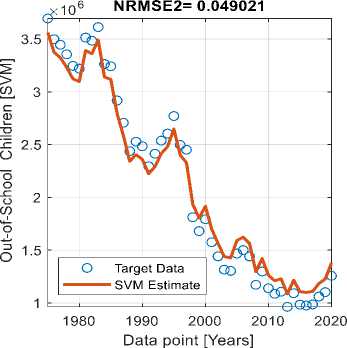
Using the Proposed Hybrid LS-SVM Method and the Ordinary SVM
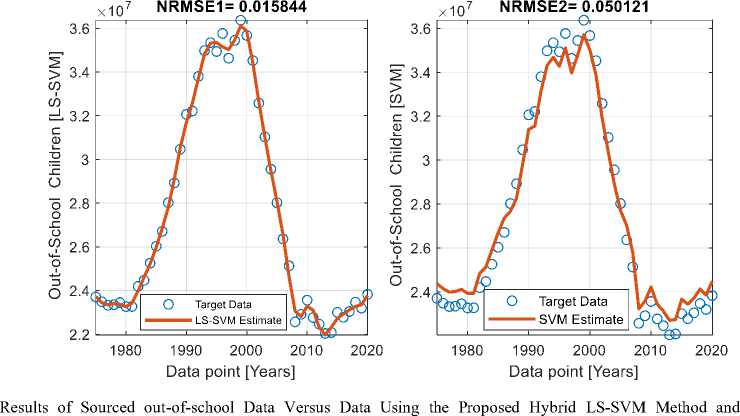
the
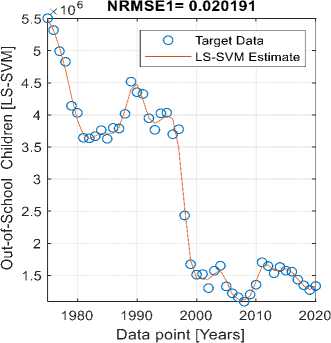
Fig.9. Predicted Results of Sourced out-of-school Data Versus Data
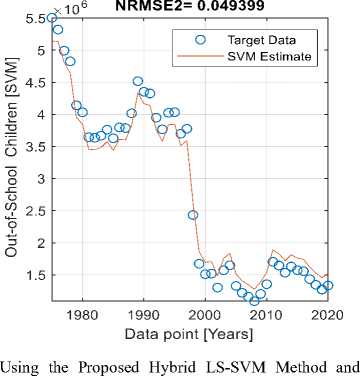
the
Ordinary SVM
Ordinary
SVM
Fig.10. Predicted
Method for LMC
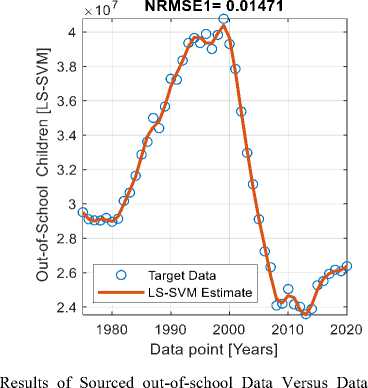
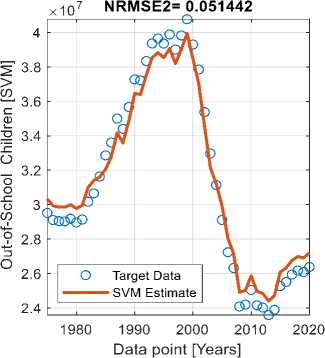
Using the Proposed Hybrid LS-SVM Method and the Ordinary SVM
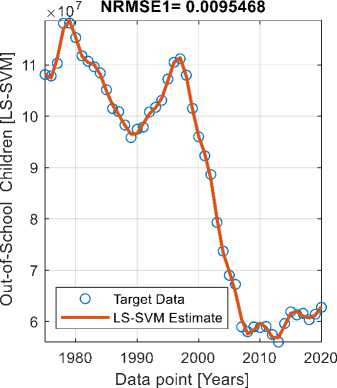
Fig.11. Predicted Results of Sourced out-of-school Data Versus Data
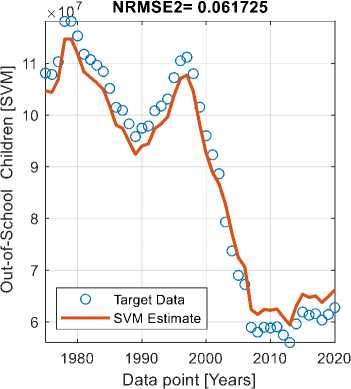
SVM Method for LDC
Using the Proposed Hybrid LS-SVM Method and the Ordinary
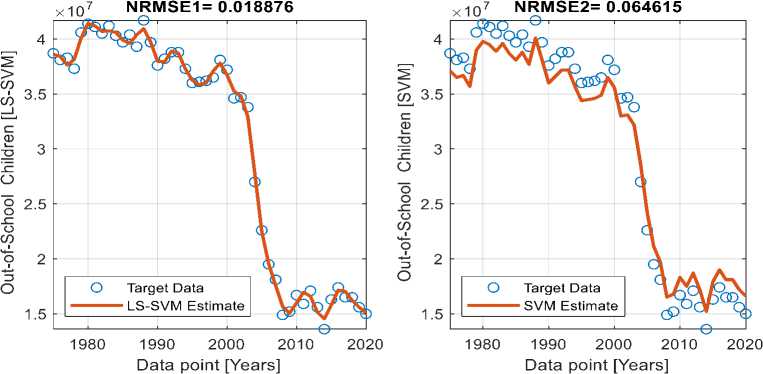
Fig.12. Predicted Results of Sourced out-of-school Data Versus Data Using the proposed hybrid LS-SVM Method and the Ordinary SVM Method for SOA
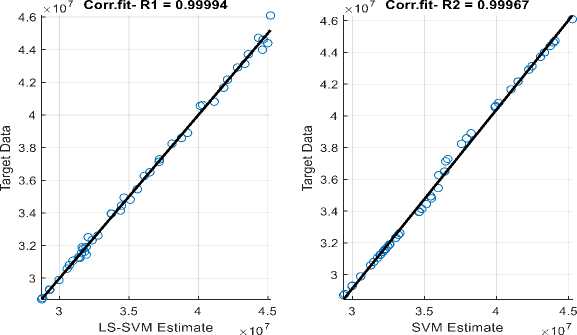
Fig.13. Correlation Performance between the Predicted and Sourced out-of-school Data the Proposed Hybrid LS-SVM Method and the Ordinary SVM Method for SSA
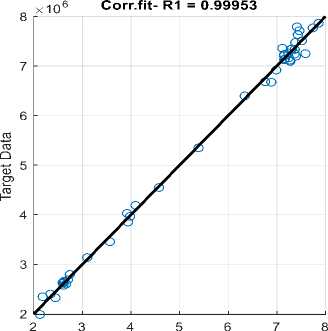
LS-SVM Estimate хю6
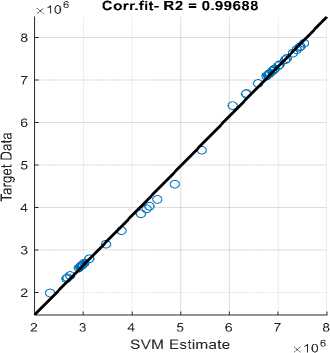
Fig.14. Correlation Performance between the Predicted and Sourced out-of-school Data the Proposed Hybrid LS-SVM Method and the Ordinary SVM Method for MEA
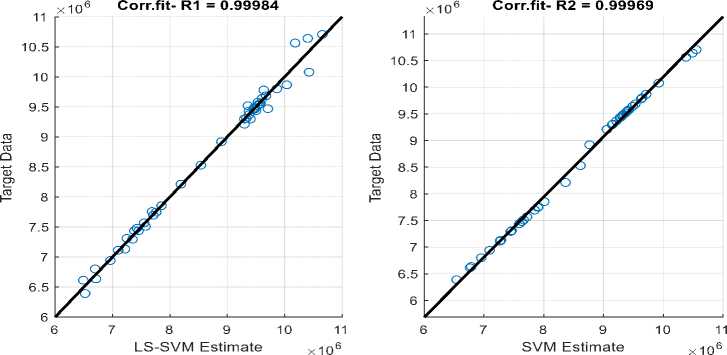
Fig.15. Correlation Performance between the Predicted and Sourced out-of-school Data the Proposed Hybrid LS-SVM Method and the Ordinary SVM Method for ARW
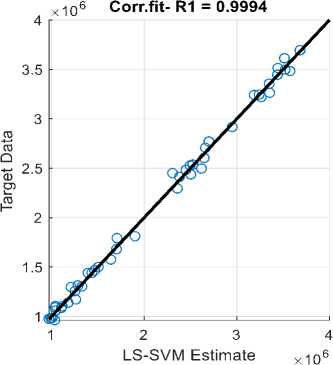
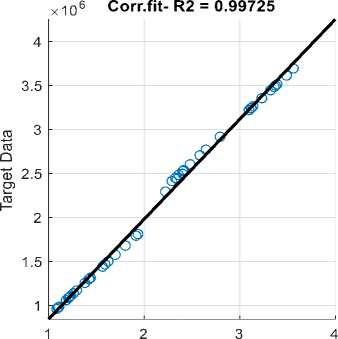
SVM Estimate x106
Fig.16. Correlation Performance between the Predicted and Sourced out-of-school Data the Proposed Hybrid LS-SVM Method and the Ordinary SVM Method for ECA
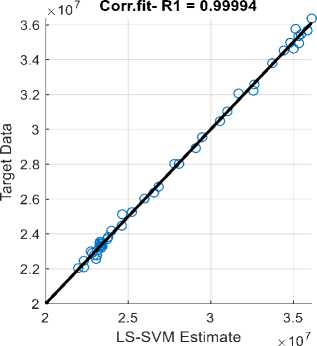
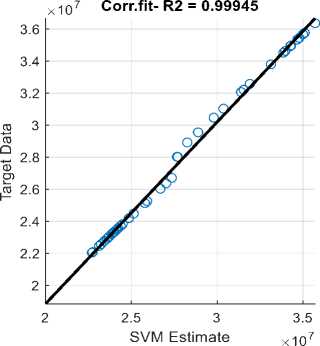
Fig.17. Correlation Performance between the Predicted and Sourced out-of-school Data the Proposed Hybrid LS-SVM Method and the Ordinary SVM Method for HIC
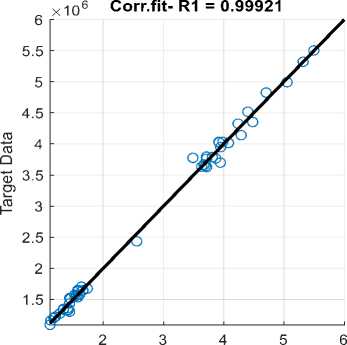
LS-SVM Estimate x106
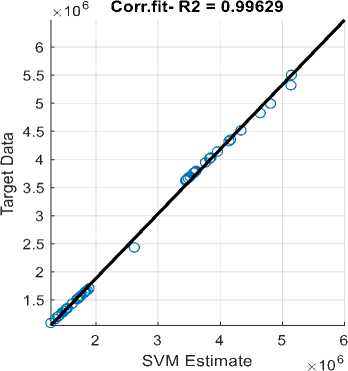
Fig.18. Correlation Performance between the Predicted and Sourced out-of-school Data the Proposed Hybrid LS-SVM Method and the Ordinary SVM Method for LAC
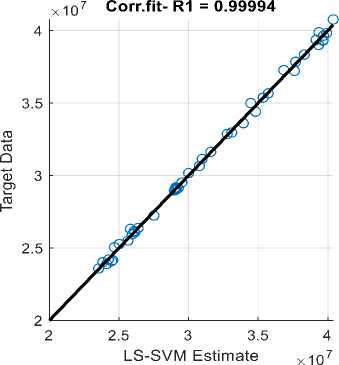
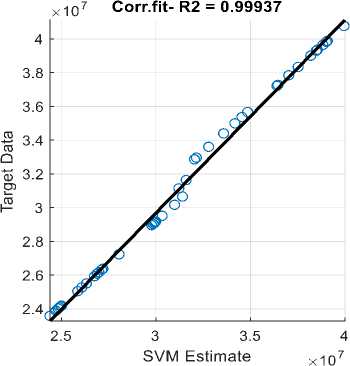
Fig.19. Correlation Performance between the Predicted and Sourced out-of-school Data the Proposed Hybrid LS-SVM Method and the Ordinary SVM Method for LMC
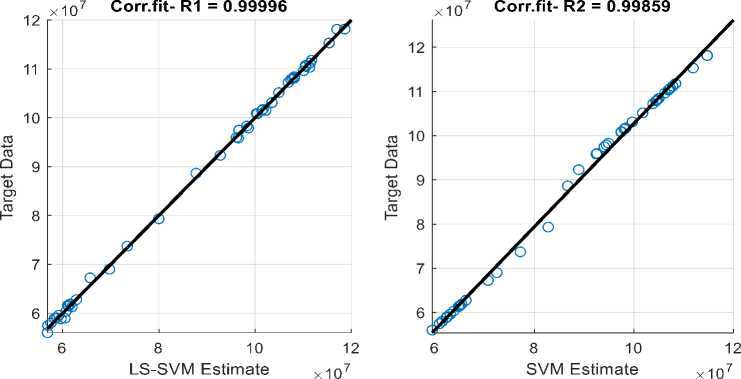
Fig.20. Correlation Performance between the Predicted and Sourced out-of-school Data the Proposed Hybrid LS-SVM Method and the Ordinary SVM Method for LDC
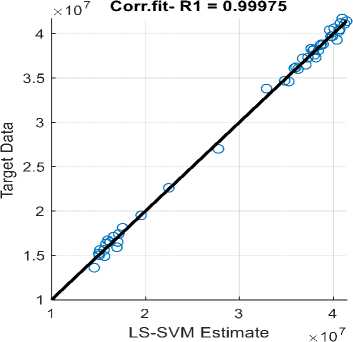
Fig.21. Correlation Performance between the Predicted and Sourced out-of-school Data the Proposed Hybrid LS-SVM Method and the Ordinary SVM Method for SOA
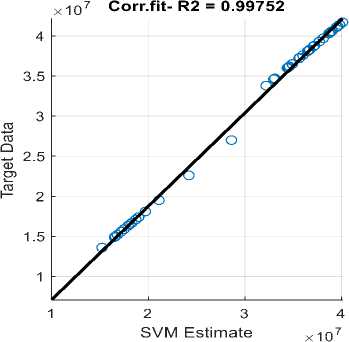
5. Conclusions
Education is generally seen as the leading pathway to pecuniary prosperity, the attested key to different technical, industrial, and scientific developments, a sure means of combating, analphabetism, poverty, and the sustaining pillar of social justice plus fairness. Therefore, the best way to empower people should be to ensure they are educated. It is to ensure they are helped to pass through the compulsory, right of free, and quality basic education. This agrees with the popular thought that education is the sure right for all children or an individual, however, this is not absolutely the case, globally.
This paper develops a better hybrid machine learning method, which combines the least square and support vector machine (LS-SVM) model for robust prediction improvement of out-of-school children trend patterns. Particularly, while other previous works only engaged some regional and few samples of out-of-school datasets, this paper focused on long-ranged global out-of-school datasets, collated by UNESCO between 1975- 2020. The proposed hybrid method exhibits the optimal precision accuracies with the LS-SVM model in comparison with ones made using the ordinary SVM model. The precision performance of both LS-SVM and SVM was quantified and a lower NRMSE value is preferred. From the graphs, the LS-SVM attained lower error values of 0.0164, 0.0221, 0.0268, 0.0209, 0.0158, 0.0201, 0.0147 and 0.0095 0.0188, compared to the SVM model that attained higher NRMSE values of 0.041, ,0.0628, 0.0381, 0.0490, 0.0501, 0.0493, 0.0514, 0.0617 and 0.0646, respectively.
Moreover, by engaging the MAPE indicator, which expresses the mean disconnection between the sourced and predicted values of the out-of-school data. By means of the MAPE, LS-SVM attained lower error values of 0.51, 1.88, 0.82, 2.38, 0.62, 2.55, 0.60, 0.60, 1.63 while SVM attained 1.83, 7.39, 1.79 7.01, 2.43, 8.79, 2.58, 4.13, 6.18. This implies that the LS-SVM model has better precision performance than the SVM model. Thus, in this paper, the following itemized contributions have been made:
-
• Detailed Statistical Analysis of out-of-School children's data for Nine different regions of the World.
-
• Development of an improved hybrid machine learning method, using the least square and support vector machine (LS-SVM) model.
-
• Application of the improved hybrid machine learning prediction method for robust prediction improvement of out-of-school children.
The above key contributions can serve as an excellent guide on how to explore hybrid machine-learning techniques to effectively study, predict and solve out-of-school students’ problems globally.
Other robust hybrid machine-learning techniques that could be engaged further to effectively study, predict and solve out-of-school students includes the kernel controlled-Gaussian process regression method [25], random forest-particle swam method [26], and least square- weighted iteration method [27, 28]. The applications of these methods are however slated for future work.
Список литературы Statistical and Machine Learning Approach for Robust Assessment Modelling of Out-of-School Children Rate: Global Perspective
- UNESCO, 2022. UNESCO Institute of Statistics Data Centre: http://www.uis.unesco.org/datacentre/pages/default.aspx
- UNICEF and its Works for Children in West and Central Africa, https:/www.unicef.org.wca.
- J. M. David and K. Balakrishnan, Prediction of Learning Disabilities in School-Age Children using SVM and Decision Tree, International Journal of Computer Science and Information Technologies, Vol. 2 (2), pp.829-835.
- Y.N. Mnyawami, H.H. Maziku and J.C. Mushi (2022) Enhanced Model for Predicting Student Dropouts in Developing Countries Using Automated Machine Learning Approach: A Case of Tanzanian’s Secondary Schools, Applied Artificial Intelligence, 36:1, 2071406, DOI: 10.1080/08839514.2022.2071406
- High-School Dropout Prediction using Machine Learning: A Danish Large-scale Study. ESANN 2015 Proceedings, European Symposium on Artificial Neural Networks, Computational Intelligence and Machine Learning, April 22-24, Bruges, Belgium.
- H. Said, 2020. Developing Dropout Predictive System for Secondary Schools, By Using Classification Algorithm: A Case Study of Tabora Region. Dodoma City: University of Dodoma.
- S. Chakraborty and A. Ghoshal, Prediction and Analysis of Dropout Secondary Students in India Using Machine Learning Classification Algorithms, Abstracts of 1st International Conference on Machine Intelligence and System Sciences, MISS-2021),1–2 November 2021, Indian.
- S. Lee and J.Y. Chung, The Machine Learning-Based Dropout Early Warning System for Improving the Performance of Dropout Prediction. Appl. Sci. 2019, 9, 3093. https://doi.org/10.3390/app9153093.
- A. O. Ameen1, M. A. Alarape, K. S. Adewole, Students’ Academic Performance, and Dropout Predictions: A Review, Malaysian Journal of Computing, 4 (2): 278-303, 2019.
- Dockery, D. J. (2012). School Dropout Indicators, Trends, and Interventions for School Counselors Donna J. Dockery Virginia Commonwealth University.
- M. Neema, Data Driven Approach for Predicting Student dropout in Secondary Schools, Ph.D. Thesis, The Nelson Mandela African Institution of Science and Technology, published in https://dspace.nm-aist.ac.tz/handle/20.500.12479/898.
- S. T. Ahmed, R. S. Al-hamdani, and M. S. Croock, Studying of Educational Data Mining Techniques, International Journal of Advanced Research in Science, Engineering and Technology, Vol. 5, Issue 5, pp.5743-5750. May 2018.
- Mukesh Kumar, A.J. Singh, Disha Handa,"Literature Survey on Educational Dropout Prediction", International Journal of Education and Management Engineering(IJEME), Vol.7, No.2, pp.8-19, 2017.DOI: 10.5815/ijeme.2017.02.02
- D.E Moreira da Silva.; E.J Solteiro Pires, A. Reis, P.B. de Moura Oliveira, and J..Barroso, Forecasting Students Dropout: A UTAD University Study. Future Internet 2022, 14, 76. https://doi.org/10.3390/fi14030076.
- R. Kenneth Koedinger et al. presented “Data mining and education”. WIREs Cogn Sci 2015. doi:10.1002/wcs.1350
- Laura Calvet Linan et al presented “Educational Data Mining and Learning Analytics: differences, similarities, and time evolution”. Universities and Knowledge Society Journal, 12(3). pp. 98-112. doi: http://dx.doi.org/10.7238/rusc.v12i3.2515.
- Ebhota, V.C, Isabona, J, and Srivastava, V.M. (2019), Environment-Adaptation Based Hybrid Neural Network Predictor for Signal Propagation Loss Prediction in Cluttered and Open Urban Microcells, Wireless Personal Communications, Vol. 104 (3), pp. 935–948.
- V.C. Ebhota, J. Isabona, and V.M. Srivastava, (2019), Investigation and Comparison of Generalization Ability of Multi-Layer Perceptron and Radial Basis Function Artificial Neural Networks for Signal Power Loss Prediction, International Journal on Communications Antenna and Propagation, Vol. 9 (1), pp. 43-54.
- V.C. Ebhota, J. Isabona, and V.M.Srivastava (2019), Effect of Learning Rate on GRNN and MLP for the Prediction of Signal Power Loss in Microcell Sub-Urban Environment, International Journal on Communications Antenna and Propagation, Vol. 9 (1), pp. 36-45.
- J. Isabona, (2021). Joint Statistical and Machine Learning Approach for Practical Data Driven Assessment of User Throughput Quality in Microcellular Radio Networks, Wireless Personal Communication (Springer), vol, 119, pp. 1661–1680.
- Joseph Isabona, Divine O. Ojuh, "Application of Levenberg-Marguardt Algorithm for Prime Radio Propagation Wave Attenuation Modelling in Typical Urban, Suburban and Rural Terrains", International Journal of Intelligent Systems and Applications(IJISA), Vol.13, No.3, pp.35-42, 2021. DOI: 10.5815/ijisa.2021.03.04
- J. Isabona, (2020), Wavelet Generalized Regression Neural Network Approach for Robust Field Strength Prediction in Open and Shadow Urban Microcells, Wireless Personal Communications, Vol. 114 (3), pp.3635–3653.
- Odesanya Ituabhor, Joseph Isabona, Jangfa T. zhimwang, Ikechi Risi, "Cascade Forward Neural Networks-based Adaptive Model for Real-time Adaptive Learning of Stochastic Signal Power Datasets", International Journal of Computer Network and Information Security(IJCNIS), Vol.14, No.3, pp.63-74, 2022. DOI: 10.5815/ijcnis.2022.03.05
- K. Obahiagbon, and J. Isabona, (2018), Generalized Regression Neural Network: an Alternative Approach for Reliable Prognostic Analysis of Spatial Signal Power Loss in Cellular Broadband Networks, International Journal of Advanced Research in Physical Science, vol. 5(10): 35-42.
- Joseph Isabona, Divine O. Ojuh," Machine Learning Based on Kernel Function Controlled Gaussian Process Regression Method for In-depth Extrapolative Analysis of Covid-19 Daily Cases Drift Rates ", International Journal of Mathematical Sciences and Computing(IJMSC), Vol.7, No.2, pp. 14-23, 2021. DOI: 10.5815/ijmsc.2021.02.02
- J. Isabona Joseph, O. Ituabhor and D.O. Ojuh.O.Divine, Poynting Vector Joint with Weighted Least Square Regression Technique for Optimal Electric Field Strength Modelling, International Journal of Computing and Digital Systems, vol.12, No.1, 517-527 (Dec-2022). https://dx.doi.org/10.12785/ijcds/1201122
- S. Hassan, Abbas Karamodin, Alireza Entezami, A new iterative model updating technique based on least squares minimal residual method using measured modal data, Applied Mathematical Modelling, Vol. 40, Issues 23–24, 10323-10341, 2016. https://doi.org/10.1016/j.apm.2016.07.015.
- O.R. Omasheye, S. Azi, J. Isabona, A.L. Imoize, C-T. Li, C-C and C-C. Lee C. Joint Random Forest and Particle Swarm Optimization for Predictive Pathloss Modeling of Wireless Signals from Cellular Networks. Future Internet; vol.14(12), 2022:373. https://doi.org/10.3390/fi14120373.

